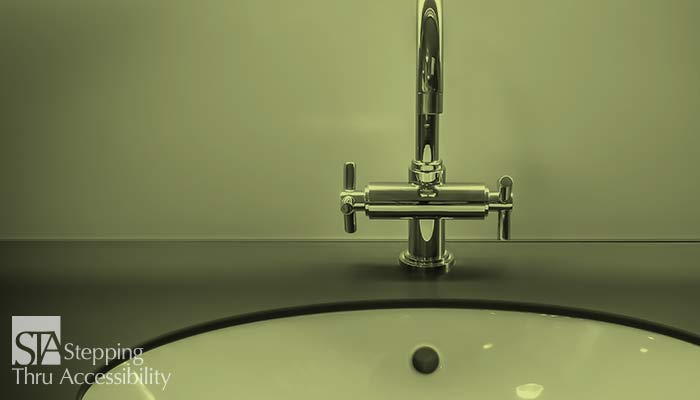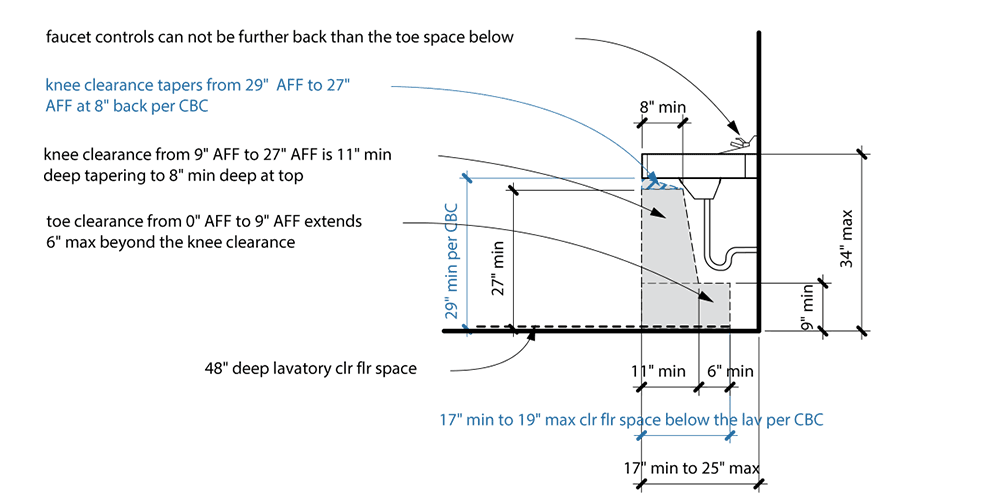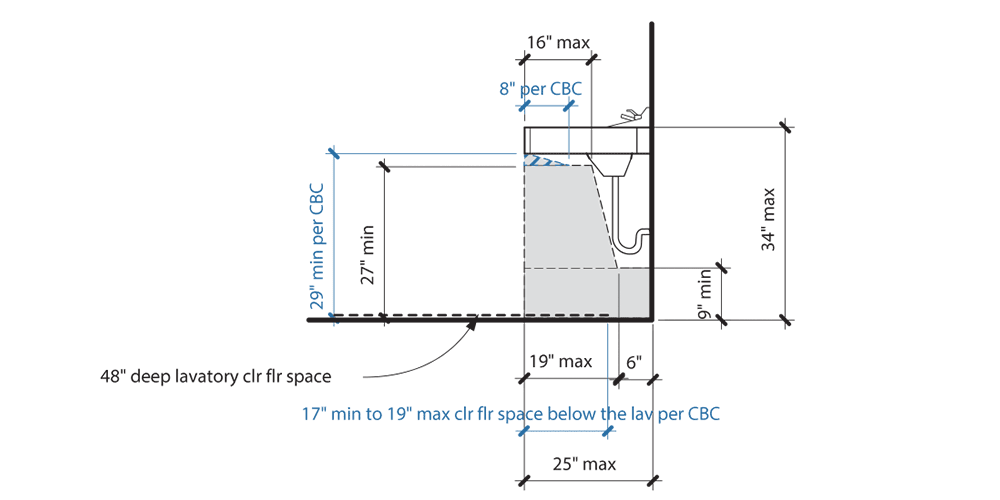Blog
Return to Blog »
Janis Kent, Architect, CASp © February, 2018 Lavatories have some of the more involved clearances below which impact reach ranges above. The question of why is this important to understand might be arising in your thoughts. The answer is the impact on the location of faucet controls, soap dispensers, and any other built-in items including electrical outlets and switches. The knee clearance under a lavatory is 27” minimum height above the finished floor (AFF) extending horizontally from the front edge to a depth of 8”. If you are working in California the height clearance tapers from the front edge at 29” AFF, down to 27” AFF at 8” back. The next portion of the knee clearance is tapered from 27” minimum AFF down to 9” minimum AFF at 11” back. The toe clearance requires an additional 6” horizontally beyond the bottom of this taper. This is nothing new, but what we often lose sight of, is this taper is at a rate of 1” depth for every 6” of height – a total of a 3” depth beyond the full 27” clear height AFF. You can increase the depth at the lower portion of the taper more than 3” but the toe clearance is still calculated as starting 3” back from the top of the taper. Another way of looking at this is the furthest point of the toe depth is an additional 9” back maximum from the start of the taper at 27” AFF. For a lavatory with front approach, you need to remember that you can not reach beyond your toes. So if you have the minimum of 8” at the top + 3” of taper (the typical 11” minimum depth requirement) + 6” for your toes this totals 17”. If this is the furthest your toes can go, the faucets and soap dispenser (if fixed) have to have their controls located within reach range. So 17” maximum from the front edge of the lavatory counter or fixture. Let’s say you want the controls located further back at 19” – the recessed depth at 27” AFF needs to increase from 8″ to 10” deep. So you would have 10” + 3” of taper + 6” for the toes to get you to 19” depth. In California the knee/toe clearance is stipulated to be 17” to 19” deep therefor the faucet controls and fixed soap dispenser always have to be within this reach range. The 2010 ADA Standards limits clear floor space depth at 25”, not 19”, which is the maximum reach depth for front approach. So outside California you would need the 27” minimum AFF clear height to a depth of 16” + 3” taper + 6” for your toes totaling 25” in order to get the maximum reach depth if something were to be placed on the back wall such as an outlet or switch. The California Building Code (CBC) does state you can have more clear floor space beyond, but this can not be used for the lavatory clear floor space requirements. So within California all of the operable parts of a lavatory are required to be 19” maximum from the front edge presuming you have increased the depth clearance to be 10” from the top front edge. Another issue, aside from the faucet control location, is if the lavatory is placed adjacent to a bathtub. The tub controls are also required to be within reach range. For instance, if the lavatory or its counter is 22” deep and the tub controls are placed on this back wall to the side of the counter, you would have to consider one of two options. So do be careful of where you place your faucet controls in relation to the clearance below and if the lavatory is adjacent to a bathtub be aware of providing knee/toe clearance to reach the controls located on the tub end wall. Related Article: Sinks, Sinks, Sinks, and Lavs – What needs to be done? One more item to consider. If the underside of the lavatory is more than 27” AFF for the front 8” or more of depth, and if the fixture (or its counter) can be approached from the side of the fixture, you might now have a protruding object that is more than 4” from the wall which would then requires a cane detectable barrier. If the front edge of the lavatory is at 27” AFF exactly, this is a non-issue. But if you are in California, the front 8” (to 10”) tapers from 29” minimum AFF down to 27” AFF. So in California, if you can approach the side of the lavatory you will most likely always have a protruding object and a cane detectable barrier is needed. This can be as simple as providing a side piece to the counter where the leading edge goes down to 27”or less AFF. But keep in mind, this side piece might need to provide 18” minimum clear from the centerline of the lavatory in California if it goes below 27” AFF. So this sums up why knee/toe clearances, reach ranges, and protruding objects for lavatories are important to understand. Be aware that your local City or County may have additional requirements that are more restrictive than the State or Federal requirements. Also, this article is an interpretation and opinion of the writer. It is meant as a summary – current original regulations should always be reviewed when making any decisions. © Janis Kent, Architect, CASp 2018The Lavatory — Clear Floor Spaces, Reach Ranges, & Protruding Objects


